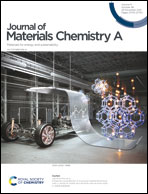Functional integration of hierarchical core–shell architectures via vertically arrayed ultrathin CuSe nanosheets decorated on hollow CuS microcages targeting highly effective sodium-ion storage†
Abstract
Functional integration of metal sulfide@selenide hetero-architectures could give significant superiority on improving sluggish kinetics and optimizing electronic structures. However, the thorough exploration of these architectures for electrochemical features and construction strategies has not attracted sufficient attention so far. Herein, hollow CuS microcubes decorated by using vertically arrayed ultrathin CuSe nanosheets (CuS@CuSe) were synthesized successfully based on a template-directed asynchronous sulfidation/selenization method at room temperature. Driven by all-around achievement in aspects of unique structural engineering and morphological features, CuS@CuSe microcubes enable abundant active storage sites, large volume evolution accommodation space, and short ion diffusion channels, thus resulting in high sodiation capacity, remarkable rate capability and exceptional cycling lifespan with an admirable capacity of 303.1 mA h g−1 at 20.0 A g−1 when galvanically de-/sodiated to the 1500th cycle, superior to its counterparts of single CuS and CuSe, as well as most reported CuS-/CuSe-based anodes when tested as an anode for sodium ion batteries. The in situ XRD and ex situ TEM characterization experiments demonstrate a multiple electronic phase-evolution mechanism involved in the interaction and conversion of the CuS@CuSe electrode. The DFT calculations reval that the excellent performance of CuS@CuSe microcubes stemmed from adequate hetero-interfaces which afford a low Na+ adsorption energy and migration energy barrier for ion transport kinetics.



 Please wait while we load your content...
Please wait while we load your content...